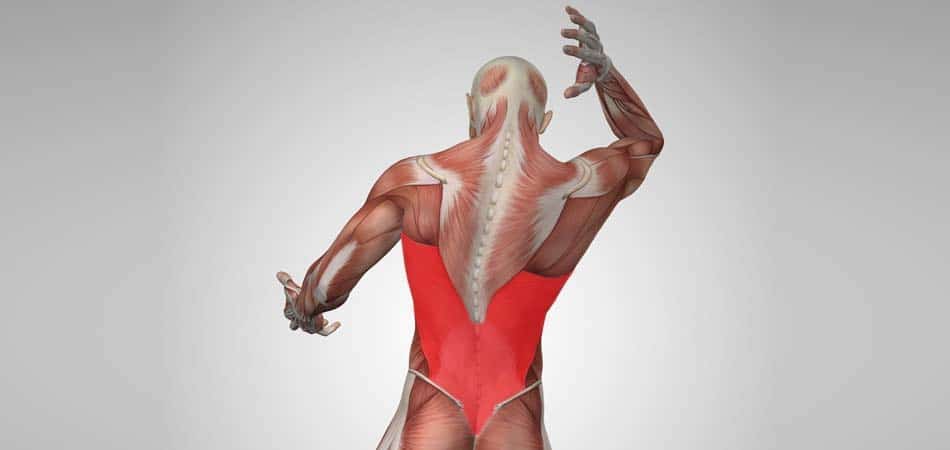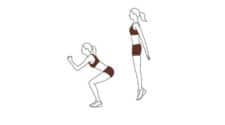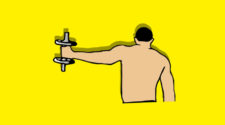Back muscles are among the largest muscles in the human body.
Usually, when gym goers train their backs, getting larger lat muscles is their first priority. Well-developed lats help you to achieve that much sought after V-tapered look. It makes your waist appear smaller, and your shoulders seem broader.
Sadly, for some people, packing muscle mass on their lats is a challenging task. It could be because of genetic factors, or it could be because they are not using the proper training techniques. You can’t change your genetics, but you can make some improvements in your training.
To help you boost muscle growth, I’ve collected various lat workout tips.
Anatomy of your lats
Before we dive into training principles, I want to give you a brief insight about lat anatomy.
When people talk about training their lats, they are referring to the muscle called Latissimus Dorsi. This is the flat, large muscle located in the middle and lower part of your back. Latissimus dorsi is the widest muscle in the body. It can be subdivided into three parts: thoracic, lumbar, and pelvic.
Lats connect to your upper arm and wrap around the side of your torso. Some researchers even refer to it as being two muscles; one located on your left, and one on your right.
These muscles play an essential role in numerous mechanical processes in the body. They assist in various shoulder functions (extension, adduction, internal rotation) and help to stabilize the spine.
Generally, lats act as stabilizer muscles for a whole variety of upper body exercises.
Key lat workout for mass training principles
Okay, now we can move further and discuss the key lat workout principles.
Prioritize your lats
The first thing you need to do to build lats mass is to make them a priority.
You should train your lats on your “best workout days.” For some of you, it might be Monday while for others it may be Friday. It’s up to you!
It is also essential to pay attention to how you combine muscle groups during your exercise routine. I suggest you don’t train any other muscle group before lats, particularly biceps. You should be really focused on hitting your lagging lats hard. Don’t tire yourself out with a lower priority muscle workout.
Sometimes you might even want to consider eliminating certain exercises from your workout routine if they could slow down your back training.
If you normally train your lats once per week, why not throw an additional lat training day in there? The harder you train them, the more likely they will be to respond to the stimuli you’re placing on them.
Of course, you can’t always keep pushing your lats to the limit. Remember to rotate heavy and light lat workouts. For instance, three weeks of heavy workouts following by one light week. The light workout will help you to recover physically and mentally. Later it will result in greater lat muscle mass gains.
Target different parts of the muscle
As your lats are so large, you’ll find that you can target them from many different angles.
In many cases, gym goers often only perform countless wide grip lat pulldowns to spread the lats. However, different exercises can target different parts of the muscle. V-bar pulldowns, for example, will help to target the thoracic (upper) and lumbar (middle) part of lats. So, be sure to vary your training and find the best exercises for you.
The thing to take away here is that it’s essential to perform different exercises when working your lats. Otherwise, you’ll inevitably hit a natural plateau.

Establish a strong mind-muscle connection
Before you can even consider building up your lats, you must first establish a strong mind-muscle connection. A mind-muscle connection will help you to focus purely on the muscle that you’re working on.
With a strong mind-muscle connection you can visualize the muscle being trained and you can work on really contracting the lats during each rep. This will not only result in greater levels of muscle hypertrophy; it will also help you to perfect your form and really isolate the lats.
Alter your grip
A little later on we’re going to look at some key lat workout for mass exercises. Before we do that, we’re going to highlight the importance of the grip when training.
You may not realize it, but switching from an underhand grip to an overhand grip or a neutral grip can change a back exercise and do wonders for your back. There are many options you can test. For example, you can try out underhand and overhand bent over barbell row.
The same goes for the grip width. You can check on how wide, narrow, and regular grip affect back exercise performance. However, I should state that studies only show a minor difference in muscle activations from changing grip width. Anyway, you should try some different grips out and draw your own conclusions.
One more option is to perform pull-ups or lat pulldowns with a thumbless grip. This grip will reduce the load placed onto the forearms during the exercise. It means that the back muscles must work harder to complete the exercise. You can check Youtube and find that many professional bodybuilders prefer a thumbless grip over a neutral grip while doing these exercises.
If your back is being stubborn and doesn’t seem to want to grow, try switching your grip, and consider going thumbless.
Increase the volume
When it comes to building up a muscular back, the volume is very important when training. In fact, experts argue that optimal training volume is considered to be the most beneficial workout variable to hasten muscle growth.
So, if you’re looking to build mass, the general rule of thumb is to step up the volume. On average, an exerciser should perform around 10 work sets on lats throughout the week.
However, you need to experiment and find what would be the ideal number in your case. I estimate that the amount of work sets could easily add up to 15. You should put real effort into forcing the stubborn muscle to grow.
Full range of motion
To get the most out of your exercises, it’s vital to execute a complete range of motion when working out. Studies reveal that a full range of motion will facilitate achieving slightly greater levels of muscle hypertrophy compared to training with a shorter range.
So, where it’s possible, try to complete exercises in the full range. This will result in an increase in lat muscle mass.
I know that there are gym goers who have muscle-related injuries and cannot following the full range. In this case, if you are one of them, switch to a shorter range of motion. This won’t change much in terms of muscle growth and can save your health.
What are the best lat workout exercises?
Here, I want to describe some of the lat workouts for mass exercises, which you can incorporate into your training. These exercises were found to be the best for lat workout by two studies.
One study was conducted by the American Council on Exercise, and the other was done by fitness authority Bret Contreras.
Weighted chin-ups
First up, we have weighted chin-ups. Generally speaking, the chin-up is considered to be absolutely fantastic when it comes to back development.
Some bodybuilders find that their own body weight isn’t sufficient enough when it comes to resistance. So, they add extra resistance, usually in the form of weight plates chained securely to a weight belt.
Weighted chin-ups work your upper and lower lats and also are great for enhancing grip and bicep strength.
Rack pulls
Rack pulls are a variant of the deadlift. They’re perfect for hitting the lower and middle lats.
The exercise is almost identical to a deadlift. The only difference is that you lift the barbell up off of a rack rather than the floor. Usually, the weight is an inch or two above the knee at the starting position.
Rack pulls are easier than deadlifts because the weight has less distance to travel. Plus, they allow you to really focus on squeezing the lats as you go.
Weighted pull-ups
Some bodybuilders claim that pull-ups is the top exercise for the latissimus dorsi development. I can only agree.
Similarly to the chin-ups, weighted pull-ups are ideal for hitting your lats. Try to experiment with grip width and find the most comfortable position where you feel your lats the most. Perform pull-ups in the wide range of repetitions to target all types of muscle fiber.
I strongly suggest you include pull-ups in your training protocol if you’re seeking to build a wider back!
Underhand grip elevated feet inverted row
Actually, I haven’t seen many gym goers who do inverted rows. Usually, outdoor exercisers prefer this exercise. Even though the inverted row isn’t quite popular, you should try it out. Who knows, maybe the inverted row will be exactly what you need to allow you to add extra inches to your lats.
When you perform an inverted row, you need to set a bar up at waist height in a rack. Now you can take an underhanded grip wider than shoulder-width and position your feet on a bench or box. Your legs should be elevated higher than your shoulders.
From this position, you simply pull yourself up off the ground until your lower pecs graze the barbell. Pause in the peak of the contraction. Then you lower yourself back down so that your arms are fully extended. Repeat for as many reps as required.
Back workouts focusing on lats
Here are two back workout examples with a focus on your lats:
- Hyperextensions – 1 set of 15 – 20 reps
- Weighted chin-ups – 4 sets of 6 -15 reps
- Inverted row – 3 sets of 8 -15 reps
- Seated Cable Row – 3 sets of 6 -12 reps
OR
- Hyperextensions – 1 set of 15 – 20 reps
- Weighted pull-ups – 4 sets of 6 -15 reps
- Rack pulls – 3 sets of 6 -12 reps
- Barbell Row – 3 sets of 6 -12 reps
As you can see, when it comes to establishing the ultimate lat workout for mass, there’s a lot to consider when training. Hopefully, these tips and exercises will help you to build a thick and powerful back to be proud of.
Reference
- Gerling ME, Brown SH. Architectural analysis and predicted
functional capability of the human latissimus dorsi muscle. J Anat. 2013;223(2):112–122.doi :10.1111/joa.12074. - ACE-SPONSORED RESEARCH: What Is the Best Back Exercise?
- Grip Width and Forearm Orientation Effects on Muscle Activity During the Lat Pull-Down.
- How should we train the latissimus dorsi?
- Inside the Muscles: Best Back and Biceps Exercises.







Leave a Reply